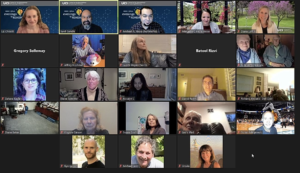The Big Idea: Navigating Our World with Dr. Liz Chrastil
By Zahara Keulen
 Dr. Liz Chrastil is a master navigator. When she was a child, she had no problem finding her way to her grandmother’s house and was skilled at finding her way around new cities. When she realized not everyone was so directionally blessed, she became interested in studying differences in how people navigate. For the March 9th Evening to Remember Big Idea Talk, Dr. Chrastil talked about her research which uses virtual reality to study navigation and answered audience questions on how people find their way around.
Dr. Liz Chrastil is a master navigator. When she was a child, she had no problem finding her way to her grandmother’s house and was skilled at finding her way around new cities. When she realized not everyone was so directionally blessed, she became interested in studying differences in how people navigate. For the March 9th Evening to Remember Big Idea Talk, Dr. Chrastil talked about her research which uses virtual reality to study navigation and answered audience questions on how people find their way around.
Navigation as “a whole-brain activity.” The hippocampus helps you remember the order in which you’ll encounter landmarks. The vestibular system tells you if you are turning left or right or moving faster, and your visual systems are constantly sending information on your position and speed. Higher processing regions help you make decisions on where you’re going, and tracts of white matter integrate all these areas. Dr. Chrastil uses functional imaging, like fMRI, to determine which areas are interacting when people commit a new environment to memory, and how that changes as you become familiar with the environment. Through studies involving imaging the brains of hundreds of participants, she also looks at how size differences in these regions may also impact memory.
Navigation not only involves different areas of the brain, it involves different strategies. You may use landmarks to guide where you’re going. You may think about the turns you took to get to your destination, then reverse them to navigate home. Even if you’re walking through a dark room, you have an idea of the direction from which you came and how far you’ve traveled. To be good at navigation, you need to use multiple strategies and be able to switch from one to another when appropriate.

Friends of the CNLM asked Dr Chrastil about a wide range of topics, including human vs animal navigation, advantages of different types of navigation, and future remedies for poor navigation.
To study the different strategies used to navigate, researchers must control the environment tightly. The Chrastil lab does this by having participants navigate through carefully constructed virtual reality environments. In some cases, this means having people navigate through a virtual maze. Although they have the visual experience of walking through green hedges, they are actually winding through an empty room used just for this purpose. In other experiments, participants navigate around a virtual desert, with no landmarks to help guide them. Removing visual landmarks allows Dr. Chrastil to study path integration, or the way your brain updates your position based on your movement.
Using virtual reality, her lab also looks at differences in navigation between the sexes and how navigation changes with age. During her talk, Dr. Chrastil described some of her findings on sex differences in navigation. Sex hormones, socialization, and the effects of stereotypes can all alter how men and women perform on navigation tests. There also can be discrepancies between someone’s ability to navigate and how they perform on a navigation task. For example, they found that women are more likely to choose a well-known route in a maze over a shortcut. However, when women are told to take the shortest route, they tend to choose the shortcut as often or more than the men do.
Aging affects how both men and women navigate. When traveling through a virtual maze, older participants tended to choose the familiar route over the shortcut. Navigation skills also tend to decline with age. This decline is steeper in men, though the baseline for women is lower. Changes in hormones during menopause may also affect how women navigate with age. The hippocampus, a major area for navigation, has a large number of estrogen receptors. Lower estrogen levels after menopause could alter how this area functions during navigation. Since poor navigation is one of the first signs of dementia, it is important to understand how navigation changes in the aging brain.
After her talk, audience members were eager to ask Dr. Chrastil about how people find their way around. Many questions focused on why people navigate differently and the function of having different navigation strategies. Dr. Chrastil described how martial artists, who move around a small ring, tend to be better at navigating in small spaces. Meanwhile soccer players, who must weave across a large field, are better at navigating through a large space. People who opt for a list of directions over a map may have trouble converting the perspective of looking down at the map into their first-person view of the environment. Visual navigators may prefer maps and landmarks to left-turn/right-turn directions.
Other audience members expressed interest in how navigation might be improved. While stating that there is still much to learn about how to strengthen navigation, Dr. Chrastil had some suggestions for what might help you become a better navigator. One strategy that she practices is turning off the step-by-step navigation on the GPS and navigating based on the map of your route instead. Another simple method she described includes making predictions about your location while you navigate around a new area. The feedback from testing the predictions may help strengthen your memory of the place. The Chrastil Lab is also trying to determine whether virtual reality can be used to strengthen certain types of navigation.
Enthusiasm was high at this evening’s talk, with questions on everything from differences in animal navigation, to how to make sure your kids learn how to navigate, to the evolutionary advantages of different navigational strategies. Dr. Chrastil discussed her approach to answering some of the big questions in navigation and talked about a new collaboration with a robotics lab. We certainly can expect lots of exciting research from the Chrastil lab in the future.
The next Evening to Remember will be held via zoom on April 20th and will feature a panel discussion of “How Memories are Made.” Evenings to Remember are open to members of Friends of the CNLM, a group dedicated to supporting research on learning and memory.

About Zahara Keulen
Zahara Keulen is a Ph.D. student in the Department of Neurobiology and Behavior at UCI. She completed her Bachelor of Science in Cellular, Molecular, and Developmental Biology at UC Santa Cruz and her Master of Science in Regenerative Medicine at Cal Poly San Luis Obispo. Zahara has worked in a variety of labs, studying everything from wine chemistry to autism, and is now researching how immune cells in the brain may affect the progression of diseases like Alzheimer’s.
